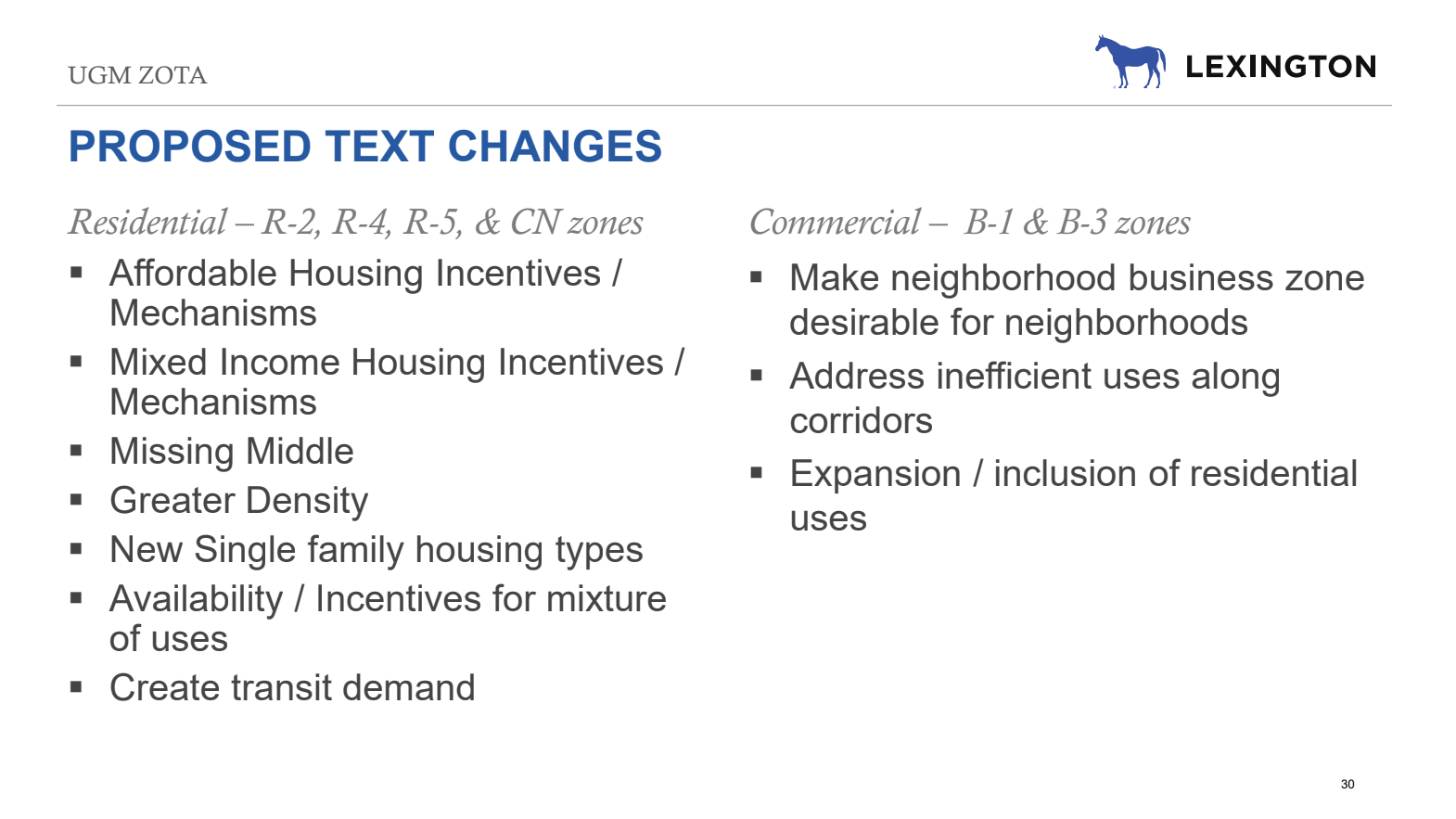Urban Growth Zoning Overhaul Heads to Committee
In Tuesday’s General Government and Planning (GGP) Committee, Hal Baillie of the Division of Planning will present on the Urban Growth Management Zoning Ordinance Text Amendment (UGM ZOTA).
The Urban Growth Management ZOTA proposes a significant number of changes aimed at advancing goals in the Comprehensive Plan related to walkability, bikeability, housing diversity, increased density, affordable housing, and environmental sustainability.
If passed, this ZOTA could have a significant impact on land use in Lexington. Here is a list of some of the potential changes:
Allowing multi-family housing (up to 8 units) on lots in R-2 Two-Family Residential zones. This would be an increase from two housing units
Where are R-2 zones? Examples of R-2 zones include many parts of Kenwick, Chevy Chase, and Waller Ave.
Removing drive-thrus and gas stations as an allowable use in the B-1 Neighborhood Business Zone.
Where are B-1 zones? Examples of B-1 zones include much of Chevy Chase, Southland Drive, and Jefferson Street.
Letting sites with affordable housing (for families at or under 80% of Area Median Income) build more units on a lot than their zone typically allows. This is called a Density Bonus.
What could this do? Affordable Housing can be expensive to develop. Allowing more units on a lot could theoretically lower the end cost per unit, potentially reducing the rent.
Changes to the B-3 Zone, which would now be called the Corridor Business Zone. The changes would reduce the number of gas stations and car lots allowed in this zone and would allow multi-family residential development like apartments.
Where are B-3 zones? Most B-3 zoning in Lexington is along North New Circle Road and Richmond Road.
Create a new Corridor Node Zone, which would prioritize walkable, high-density commercial and residential developments along corridors with current and future transit access. It would also prohibit surface parking lots, requiring most parking either be in a garage or along a side-street.
You can review the full Urban Growth Management ZOTA here.
The Planning Commission unanimously passed the UGM ZOTA in December, but there have been some changes since. Those are:
The addition of a Workforce Housing Density Bonus, which would allow housing developments reserved for residents making 120% or lower of the Area Median Income (AMI) to build more units than typically permitted in their zone.
The removal of maximum setbacks for residential buildings in the R-2 (Low Density Residential), R-4 (Medium Density Residential), and R-5 (High Density Residential) zones.
In many zones, buildings must be a certain distance away from the front of the lot they are on — this distance is called a setback.
Eliminating setback requirements may provide developers more flexibility in developing on smaller lots, or lots with unique challenges like significant trees that need protection.
Councilmembers’ questions largely centered on two provisions of the ZOTA: the prohibition of gas stations and drive-thrus in the B-1 (Neighborhood Business) Zone.
Baillie clarified that existing gas stations and drive-thru businesses will be able to continue operation if the ZOTA passes, and that those uses would continue to be permitted at existing properties if ownership were to change.
The ZOTA also allows drive-up windows for businesses like dry cleaners, banks, and pharmacies, which are less obstructive and traffic-inducing than drive-thru restaurants.
Other clarifying questions centered around amendments to residential zones, including allowing up to 8 multifamily units per building in the R2 Zone (Low-Density Residential), the creation of Cottage Housing regulations to allow multiple single-family detached homes on one lot, and the creation of a new Corridor Node zone with minimum density requirements to create transit demand.
GGP Committee Chair Preston Worley asked Councilmembers not to make any motions or changes to the ZOTA, saying that the Committee would return to this ZOTA and workshop it in a separate meeting. The next scheduled GGP Committee meeting is in April, but the Committee could call a special meeting before then to work on the ZOTA.

